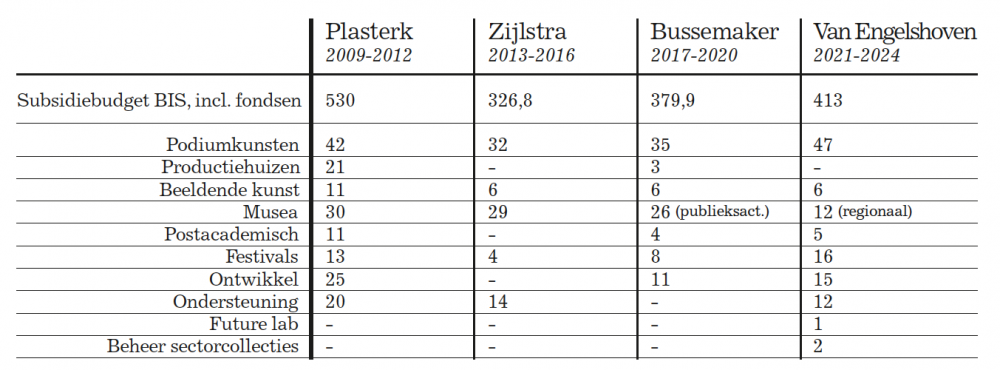Emergence and development of Basic Cultural Infrastructure
The Boekman Exploration 'The Origins and Development of the Basic Cultural Infrastructure' appeared in September this year and offers a brief look back at the origins and organization of the Basic Cultural Infrastructure (BIS). What subsidy criteria did successive administrators apply to its interpretation? The cultural policy of Ronald Plasterk (2009-2012), Halbe Zijlstra (2013-2016), Jet Bussemaker (2017-2020) and Ingrid van Engelshoven (2021-2024) is described in a nutshell by Jack van der Leden, based on documents from the Boekman Foundation's Knowledge Base.

2009-2012
The history of the Cultural Basic Infrastructure started in 2009 under Minister of Culture Ronald Plasterk. His predecessor, State Secretary Mady van de Laan, was already advocating a political debate that would focus on the main issues and not revolve around decisions at the institutional level. Under Plasterk, Van der Laan's ideas were converted into regulations that led to the establishment of the BIS. From now on the central government would only grant subsidies directly to a limited number of institutions that together form a basic cultural infrastructure. These were institutions that played a vital role in the regional cultural offering or had a national function. Under the motto "remote control," the various cultural funds were given a larger role. The Basic Infrastructure had to provide more room for talent development and a strong, innovative and internationally oriented cultural sector. It was also important for all institutions in the Basic Infrastructure to be firmly rooted in society and to generate more of their own income.
2013-2016
As early as 2010, the Basic Infrastructure underwent a major adjustment under State Secretary Halbe Zijlstra, who committed to less subsidy dependence and a sharp selection of institutions to be funded. Institutions and artists were to obtain a larger part of their income themselves and would therefore become less dependent and more flexible. Despite fierce protests, drastic cuts are being made to the culture budget: 200 million euros from 2013, of which approximately 125 million euros will be spent on the BIS. The responsibility for talent development will fall to large institutions and the cultural funds. Post-academic institutions and production houses for the performing arts will disappear from the BIS.
2017-2020
Minister Jet Bussemaker points out that the subsidized sector is still in the process of finding an appropriate response to the cuts under her predecessor. Bussemaker is generally satisfied with the system, but wants to improve its operation and quality through more cooperation between the authorities and by taking more account of actual performance in the assessment. Bussemaker wants to put quality first and steer towards demonstrable results, encourage innovation and profiling, stimulate collaboration with municipalities and provinces, and appeal to a more diverse audience. There will be extra money for festivals and talent development, the post-academic courses will again receive structural funding, as will the production houses and youth companies. The cultural funds will have more room to maneuver and may again grant subsidies for four years instead of two.
2021-2024
Under Minister Ingrid van Engelshoven, the Fair Practice Code, the Governance Code of Culture and the Code of Cultural Diversity become conditions for eligibility for funding. There is attention for innovative genres, festivals and talent development. Stimulating cooperation with the regions also receives a lot of attention. Under Van Engelshoven, more money is available and more institutions receive subsidies. The emphasis on entrepreneurship and personal income is increasingly giving way to a focus on artistic quality and social embedding and added value.

This diagram is taken from Boekman Extra September 2021. BIS subsidy budget, including funds (per annum, in millions of euros) and numbers of institutions by function/sector, by memorandum on culture since 2009-2012 Sources: Plasterk 2008b, bijl. 1, Zijlstra 2012, bijl. 3, Bussemaker 2016a, Engelshoven 2020
Downloads



